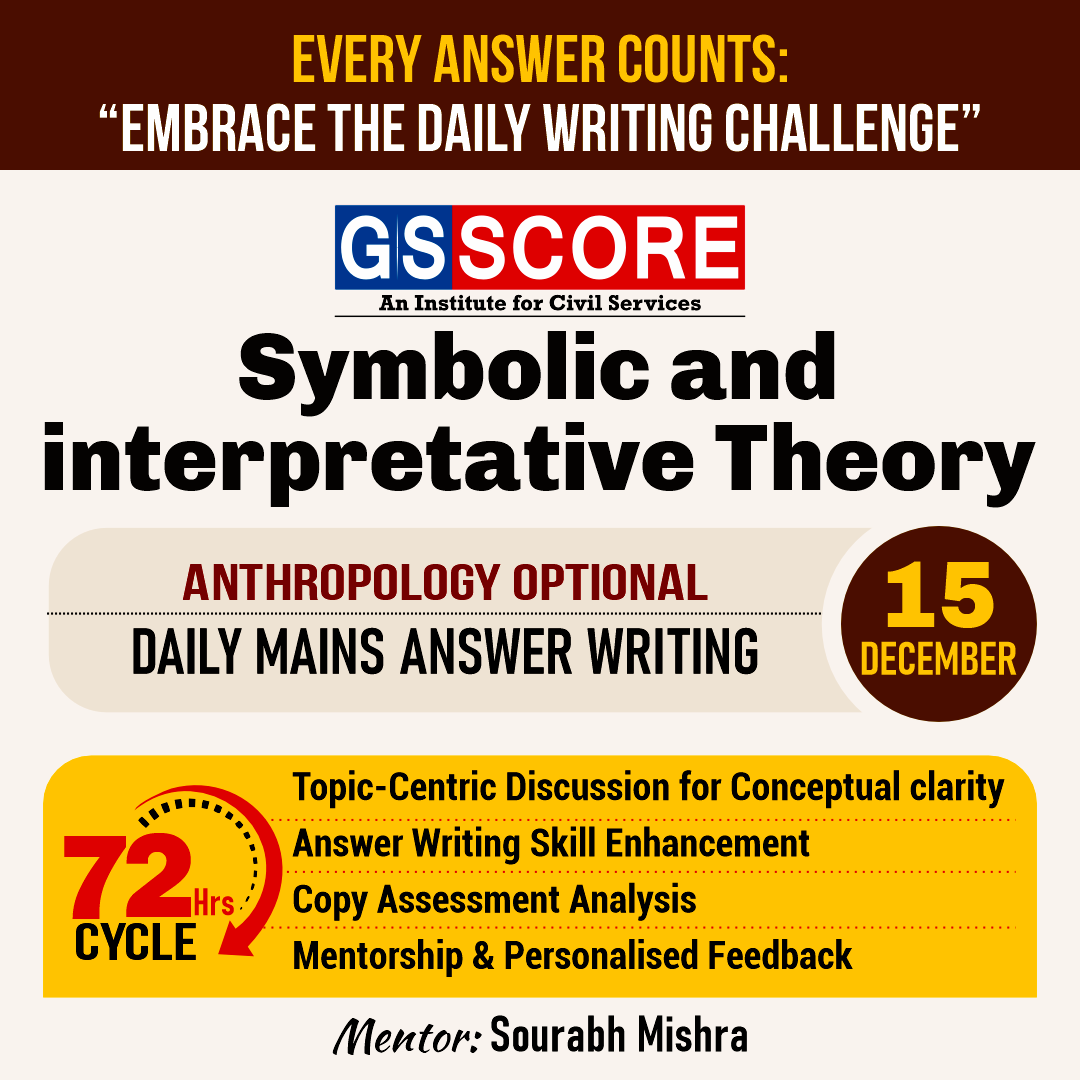


Instruction:
- There will be 2 questions carrying the First Question is-10 marks Write your answers in 150 words and the Second Question is-15 marks Write your answers in 250 words.
- Any page left blank in the answer-book must be crossed out clearly.
- Evaluated Copy will be re-uploaded on the same thread after 2 days of uploading the copy.
- Discussion of the question and one to one answer improvement session of evaluated copies will be conducted through Google Meet with concerned faculty. You will be informed via mail or SMS for the discussion.
Question #1. Thick description of Clifford Geertz. 10 marks (150 words)
Question #2. Victor Turner and liminality. 15 marks (250 words)
(Examiner will pay special attention to the candidate's grasp of his/her material, its relevance to the subject chosen, and to his/ her ability to think constructively and to present his/her ideas concisely, logically and effectively).
STEPS & INSTRUCTIONS for uploading the answers
Step 1 - The Question for the day is provided below these instructions. It will be available at 7:00 AM.
Step 2 - Uploading of Answers : Write the answer in A4 Sheet leaving proper margins for comments and feedback and upload the PDF in MY ACCOUNT section. Click on the option of SUBMIT COPY to upload the PDF.
Step 3 - Deadline for Uploading Answers: The students shall upload their answers by 7:00 PM in the evening same day. The first 50 copies will be evaluated.
Step 4 - Feedback : Mentors will give their feedback for the answers uploaded. For more personalised feedback, join our telegram channel by clicking on the link https://t.me/mains_answer_writing_cse . A one-to-one session will be conducted with the faculty after copy evaluation in 72 Hrs.
Model Answer
Question #1. Thick description of Clifford Geertz. 10 marks (150 words)
Approach
- Introduce the thick description of Clifford Geertz
- Theory of Clifford Geertz in the context of Culture
- Clifford Geertz's definition of Religion that is associated with the Culture
- Geertz's interpretive approach
- Conclusion
Hints:
Introduction:
Geertz described the practice of thick description as a way of providing cultural context and meaning that people place on actions, words, things, etc. Thick descriptions provide enough context so that a person outside the culture can make meaning of the behaviour
Theory of Clifford Geertz in the context of Culture:
- He argued that culture is made up of the meanings people find to make sense of their lives and to guide their actions. Interpretive social science is an attempt to engage those meanings. Unlike other anthropological scholars, Geertz did not focus on so-called primitive groups.
- The thick description of Clifford Geertz is based on observation, description, interpretation, and analysis of a situation.
- According to Geertz, Culture is a system of inherited conceptions expressed in symbolic forms by means by which men communicate, perpetuate, and develop their knowledge about and attitudes toward life.
- The function of culture is to impose meaning on the world and make it understandable.
Clifford Geertz’s definition of religion:
- Religion is a system of symbols that acts to establish powerful, pervasive, and long-lasting moods in men by formulating conceptions of a general order of existence and clothing those conceptions with such an aura of factuality that the moods.
- Geertz aims to provide social science with an understanding and appreciation of thick description. While Geertz applies thick description in the direction of anthropological study (specifically his own ‘interpretive anthropology’), his theory that asserts the essentially semiotic nature of culture has many implications.
Geertz’s interpretive approach:
- Geertz saw the task of interpretive anthropology as fundamentally about getting some idea of how people conceptualize and understand their world, what they are doing, and how they are going about doing it, to get an idea of their world.
Conclusion:
One of the central points in Geertz’s thesis is that religious beliefs do not merely interpret social and psychological processes in cosmic terms, they also shape them. Religions differ in terms of the complexity with which they do it. The complexity of religion is not dependent upon the scale of evolution of society.
Question #2. Victor Turner and liminality. 15 marks (250 words)
Approach
- Introduce the liminality and Symbolic view of Turner
- Historical Background
- Causes of liminality
- Victor Turner's Perspective
- Case Studies on the Ndembu community of Africa
- Conclusion
Hints:
Introduction:
Symbolic and interpretive anthropology is the study of cultural symbols and how those symbols can be used to gain a better understanding of a particular society. Although Turner in deference to his times did acknowledge that in the long run there must be some cohesive system to everything. In anthropology, liminality is the quality of ambiguity or disorientation that occurs in the middle stage of a rite of passage, when participants no longer hold their pre-ritual status but have not yet begun the transition to the status they will hold when the rite is complete.
Historical Background:
- The concept of liminality in rituals was introduced by Van Gennep (1909) and elaborated on by Victor Turner and Edmund Leach. A liminal period is ‘a betwixt and between’ period where normal life and time stand still or are reversed.
- Turner differed from Geertz’s symbolic anthropology, providing a different approach to studying cultural symbols.
Causes of liminality:
- It refers to the threshold passageway between two separate places. The liminal state is therefore a transitional one, the result of crossing a threshold between location, status, position, mental state, social condition, war, and peace, or illness and death.
Victor Turner’s Perspective
- He stated that symbols are of interest not as vehicles of, and analytic windows onto, “culture” (the integrated ethos and worldview of a society), but they are significant as being operators in the social process.
- This implies that symbols, when put together in certain arrangements in certain contexts (especially rituals), produce essentially social transformations.
- Thus, symbols in curing or initiation or hunting rituals of the people are to be explored for the ways in which they move actors from one status to another, resolve social contradictions, and wed actors to the categories and norms of their society.
- Victor Turner (1969) has shown how rituals may provide a creative space for the creation of an anti-establishment or anti-structural space that communicates a criticism of the established social norms and values.
- Thus, the ritual may act either way both to functionally establish values and to create a situation by which the tensions of oppression are released.
Case Studies:
- Victor Turner’s works are today read as seminal in the area of anthropology of symbolism or symbolic anthropology.
- The ethnographic community was the Ndembu of Africa and he published several books based on his work on them, beginning with Schism and Continuity in an African Society (1957).
- The book that we have chosen is not strictly an ethnography like his earlier book but focuses on the major contribution of Turner to anthropological theory, that of symbolism, primarily of rituals and that too of life cycle rituals.
- But since is it all about one single culture, it can be treated like an ethnography. This work also compares with the earlier one in that it deals with the process of growing up in a culture and how a culture deals with the formation of a new sexual being, a social person who will then become a full-fledged member of that society.
- While Mead has dealt with the process of socialisation and the formation of a psychosocial human being, Turner looks at the role of dominant symbols in both capturing and disseminating meanings about life to the members of a culture.
- It is the symbols that inscribe the emotions and the psychological state of making a transition from a child to an adult.
In terms of social structure and time, Liminality is an intermediate state of being “in-between” in which individuals are striped from their usual identity and they’re constituting social differences while being on the verge of personal or social transformation.
Conclusion:
Symbolic and interpretive anthropology is the study of cultural symbols and how those symbols can be used to gain a better understanding of a particular society.
In the present and in a specific situation he is able to identify much fluidity and lack of cohesion. In fact, Turner is among those pioneer anthropologists who broke away from the picture of perfectly harmonious functionally integrated systems to analyse societies as dynamic and internally contradictory. Along with this primary duty, social persons take on other duties situated in the realm of economy, politics, and religion.


